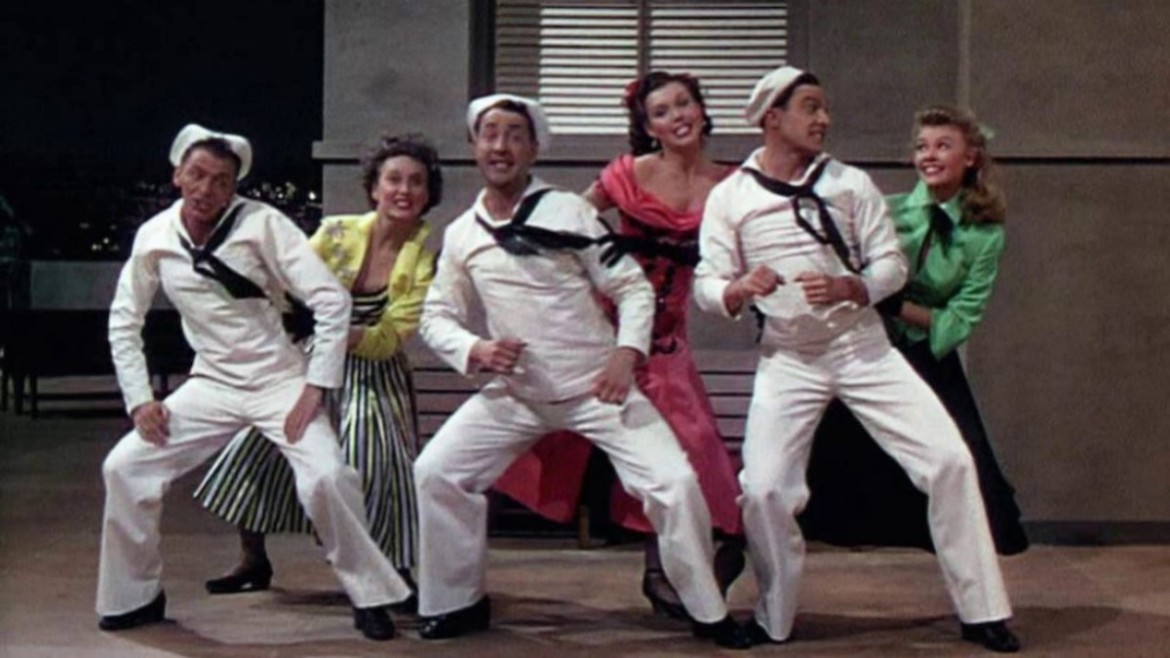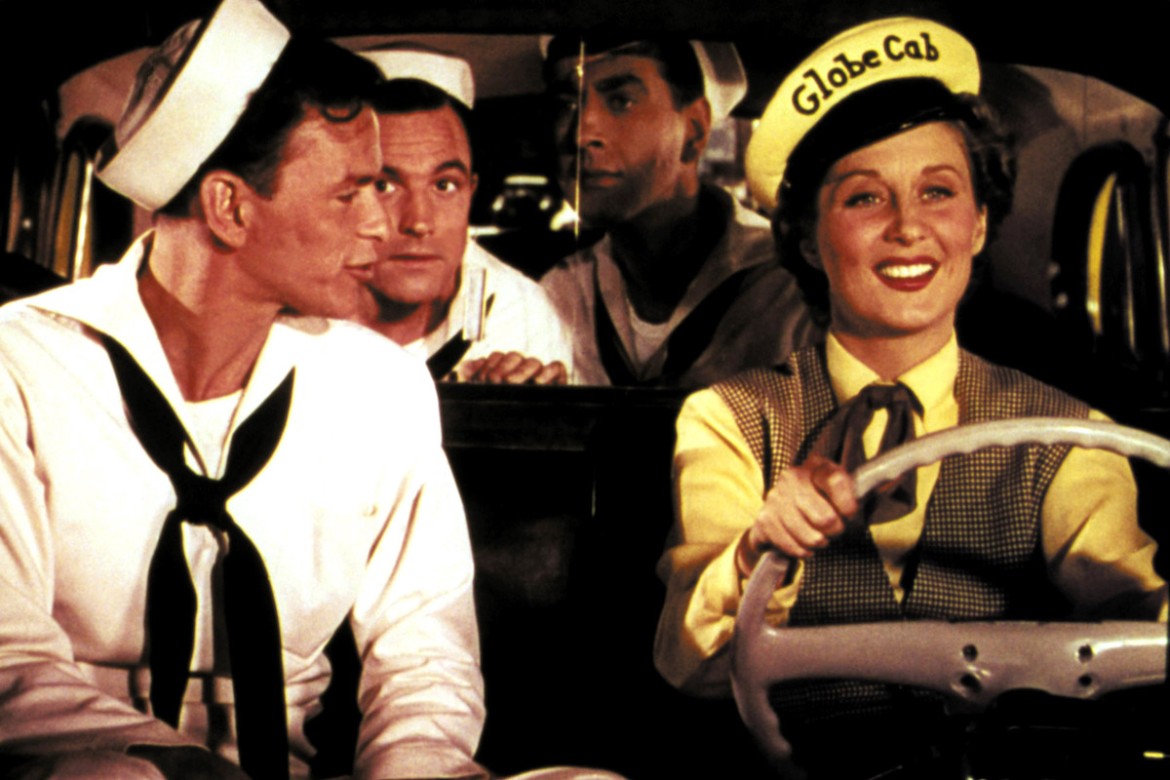The MGM musicals of the classic Hollywood era are a special breed of adorable. The movies coming out of the iconic studio during the post World War II era look at the post war homefront through a special set of rose colored nostalgia goggles. From a superficial level, the 1949 musical On the Town seems to be another similar entry into this genre. However, the intermingling of character development and fascinating performances actually craft the featured as incredibly timely in the interesting period in American history.
The movie follows three sailors played by Gene Kelly, Jules Munshin and Frank Sinatra as they enjoy 24 hours of leave – and everything that implies- in New York City. This includes the company of three ladies, played with equal gusto by Ann Miller, Vera-Ellen and Betty Garrett. Gene Kelly and Stanley Donen direct the film based on the musical (of the same name) by Betty Comden and Adolph Green.
On the Town remains a standard, but highly polished feature from a studio known for their entries into the genre. However, the potentially problematic war time story is made more interesting by layered characterization and development, particularly of its female characters.
On the Town is the third of three pairings between Frank Sinatra and Gene Kelly: beginning with Anchors Away in 1945 and Take Me Out to the Ballgame also in 1949. On the Town is a nostalgic favorite of mine dating to when I first watched it during a middle school marathoning of everything Frank Sinatra related I could get my hands on.

The movie brings together a decidedly A-List cast from the MGM’s musical peak. These are some of the studio’s biggest stars and are all seen at the peak of their powers. The feature is a must see particularly for fans of Betty Garrett and Jules Munshin, who gets a relatively rare opportunity to shine in a primary role. The actor often stole the show in character roles, but On the Town puts him alongside two of the biggest musical performers of the era and he kills it.
On the Town brings impressive on location shooting, putting the iconic nostalgia of 1940s New York squarely in focus. As directors, Donen and Kelly raise the city as a star of the film, and it’s easy to find yourself pulled into the sailor‘s all-encompassing awe at their surroundings.
Interestingly, the location shooting proved to be a challenge. In the movie‘s first number “On the Town”, look towards the top of the frame when the boys dance in front of Rockefeller Center to see the massive crowds which congregated to watch the filming. Sources point in particular to Frank Sinatra’s immense popularity during the time as fuel for the fandom fire.
It was only a few years earlier that the crooner found himself at the center of all-out riots during his performances at The Paramount Theater. A New York Daily News article from October 1944 describes the scene outside the theater, “Shortly after 10 A.M., 3,600 of them were wedged into the theatre, while outside a passionate 25,000 contended with the cops.” It was 10am and authorities were forced to detour traffic into the afternoon to contend with massive crowds. While his stock was decreasing a bit as an idol to the Bobby-soxer set, Sinatra was quickly evolving into the iconic figure he would become with the passage of time.

Meanwhile, On the Town comes shortly before Betty Garrett’s blacklisting in 1951. She married actor Larry Parks in 1944 and according to an ABC obituary, MGM dropped Garrett after her husband was called in front of the House Unamerican Activities Committee (HUAC). He admitted to being a member of the Communist Party, and both were blacklisted. Garrett wouldn’t work again until the musical remake My Sister Eileen in 1955, and largely worked on television after that. Classic tv fans will undoubtedly recognize Garrett from her work on the ground-breaking 1970s sitcom All in the Family. An Oscar winner before his blacklisting, Parks only scored a handful more screen roles, mostly on television. He and Garrett worked primarily on stage until his death in 1975.
The film walks a fairly tricky line in following sailors with much needed shore-leave… not to mention it’s post-WWII setting. There is most certainly some time period friendly wolffish behavior. Boys will be boys, after all (Sigh).
While On the Town assumes the perspective of our masculine protagonists, the female leads quickly take the opportunity to shine and runaway with it. This is particularly true with Betty Garrett as Hildy, the lady cabdriver and Claire, the anthropologist conducting a scientific study of men in hopes of getting them out of her system. Unfortunately, Vera-Ellen isn’t given much of an opportunity to shine unlike her domination in White Christmas a few years later.
The development of the female characters (particularly Claire and Hildy) feels very accurate to this post-war period. Audiences are first introduced to Hildy when Chip (Sinatra) looks her over through the window of her cab, “Why are you still driving a cab? The war’s over”. She looks back at him, not bothering to hide the interest in her eyes: “I never give up anything I like”. This is quite the character introduction.
Meanwhile, viewers are introduced to Claire inside a museum. She can barely hides her own glee as she discovers Ozzie is a dead-ringer for a pre-historic man.
[youtube https://www.youtube.com/watch?v=8Qb-Dxw9pMk&w=560&h=315]
On The Town works largely thanks to the smart and empowered portrayals of these women. Both match well their male co-stars, going toe to toe with them in their intellect and power. Taking it a step further, neither simply wilts into the narrative’s male. In fact, both Claire and Hildy openly gaze back at their male counterparts unafraid to hide their own desire. This is seen almost immediately upon Hildy’s introduction. After her above line directed at Chip, she then repeatedly proposes that they “Go up to her place”. There is even a song about it, appropriately entitled “Come Up to My Place”.
[youtube https://www.youtube.com/watch?v=fQj3sbXivYY&w=560&h=315]
In fact, much of the narrative is carried by Claire and Hildy. It is thanks to their efforts that Miss. Turnstiles bubble isn’t popped a lot sooner. We see Claire bribing waiters to bring over drinks as “compliments” of the house. It is Claire who gets them a good table at the restaurant to convince the boys Miss. Turnstiles is a popular celebrity.
Diving into these characters, their strength and agency is paramount to the story. Both women propel the narrative through to its conclusion, protecting the almost naïve sailors from the realities of big city life. While it is disguised as “for the Navy any time!” in a showing of pride which would resonate with a still freshly post war audience, there are also hints of the changing gender standards of this period, particularly the sense of wounded and fragile masculinity often seen strikingly in film noir.
Unfortunately, Ivy largely defined by two things. The first is her identity as ‘Miss. Turnstitles‘ which is shaped by who is looking at her as either a big-time celebrity or a no-body. In fact, the movie crafts a whole dance number where Gabey reads a poster about Ivy and daydreams what she must be like. As such, he’s defining who Ivy is, much of which sticks around for the movie.
The second is her identify as a small-town girl. Viewers receive a brief insight to this as she takes a private ballet lesson, bemoaning her job as a “cooch dancer” on Coney Island. Her instructor threatens to only expose her less than stellar job to her parents back home if she can’t afford her ballet classes. Unfortunately, this development is present as little more than a plot device. What depth it does give Ivy is superficial as she conforms to a rather simplistic quiet and shy archetype. While Claire and Hildy are the big city girls, Ivy is the narrative equivalent of a more desirable, passive femininity.
[youtube https://www.youtube.com/watch?v=Br706_plUFk&w=560&h=315]
Vera-Ellen is at her best in the dance numbers. She shows herself a stellar partner for Gene Kelly, matching with him in ways what few performers who weren’t named Donald O’Connor or Cyd Charisse could. The two are effervescent in “Main Street”. Occurring just about half way through the film, the simple sweet song isn’t one of the film’s biggest or most memorable numbers, but both are not only honed into their characters, but their chemistry comes across clearly in their dancing.

Watching the film with an inquiring eye shows the narrative that is incredibly tuned in culturally. The film is packed with pop culture references ranging from Dr. Kinsey to Shirley Temple.
The Dr. Kinsey reference is particularly interesting, as the University of Indiana sex researcher came on the scene in 1948 with the publication of “Sexual Behavior in the Human Male“. This was still three years before he flipped sexual ideals on their head when he released his 1953 study “Sexual Behavior in the Human Female“.
On the surface, On the Town has the appearance of a fairly standard MGM musical from the height of the studio’s movie making powers. However, upon a deeper viewing, the film demonstrates an interesting use of gender norms in a period where standards were heavily in flux.
On The Town is currently streaming on FilmStruck.
